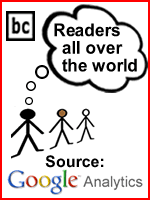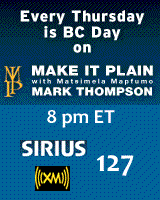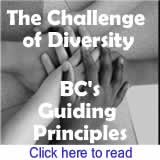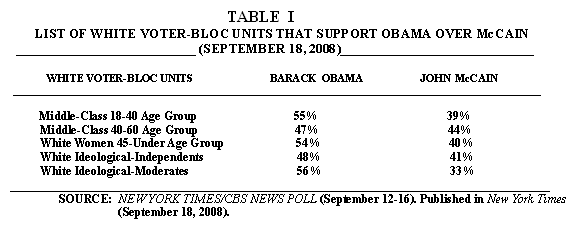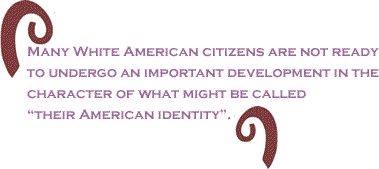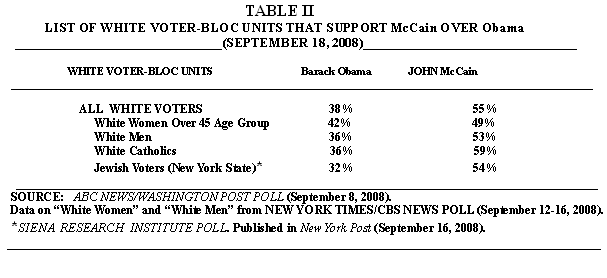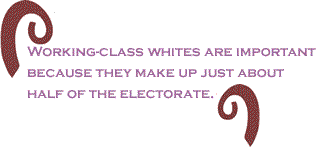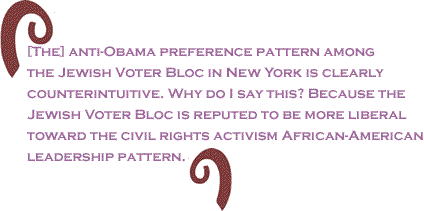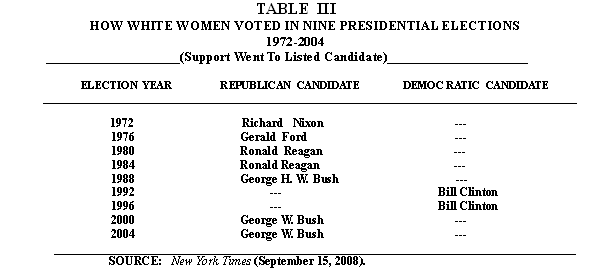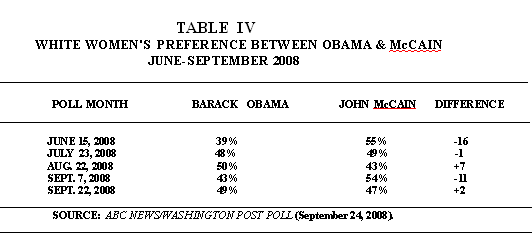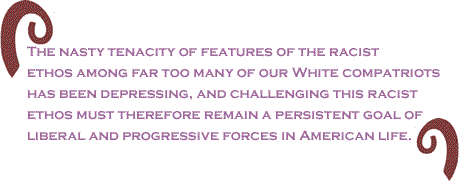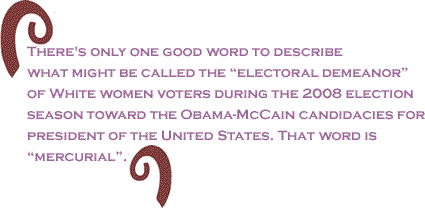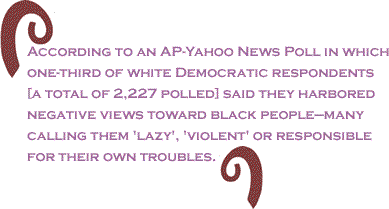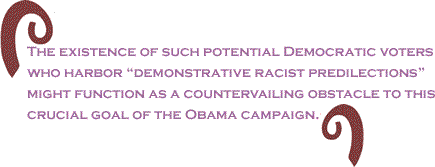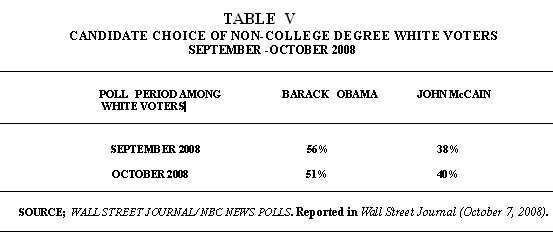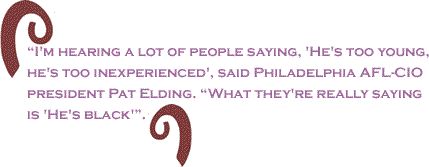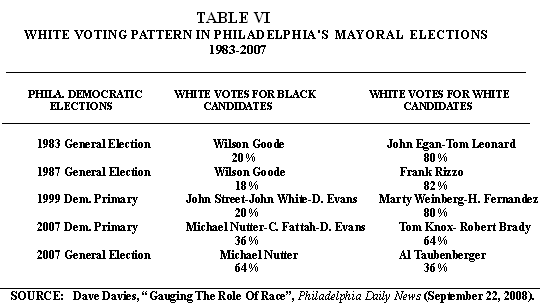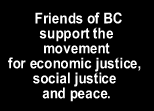
|
|||||||||||||||||||||||
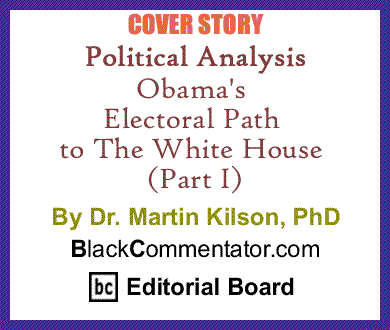
|
|||

Custom Search
|
|||
 |
|||
INTRODUCTORY It was in January 2007 that first-term United States Senator Barack Obama officially entered the campaign for the Democratic Party presidential nomination. Twelve-months later Senator Obama, 46 years old, gained victory in the Iowa Caucus primary on January 3, 2008—Obama 38%, Edwards 33%, Clinton 29%. Obama's Iowa victory warranted the following headline in the New York Times (January 4, 2008): “New Face And A Call For Change Shake Up The Democratic Field.” Recall for a minute just how politically stunning Senator Barack Obama's victory in the Iowa Caucus primary was. Obama's campaign demonstrated that an African-American candidate for a major political party's presidential nomination could emerge victorious in a primary where the state's voters are 95%-plus White Americans, besting two major White candidates of high prominence. This is my ninth article for Black Commentator.com on the Obama campaign. When writing my first article for the January 17, 2008 issue of Black Commentator, I had a fervent feeling about the Obama campaign's political-culture roots, so to speak, and I thought it useful to inform Black Commentator's readers of this. The Obama campaign's political-culture roots were, for me, clear and unambiguous. Namely, the Obama campaign stood-on-the-shoulders-of-Jesse Jackson's 1984 and 1988 campaign quests, which were undertaken, of course, at a less politically propitious point in time. Jackson's campaign-quests occurred in an era during the consolidation of a systemically reactionary Republican oligarchic-plutocratic conservatism. A conservatism which—after two Reagan administrations and a Bush I administration and two Bush II administrations—has literally ravaged social-equalitarian patterns and opportunities in American life. In my Black Commentator (January 17, 2008) article, I formulated the crucial historic linkage between Jesse Jackson's primary campaign innovations and the 2008 Obama campaign as follows:
I am writing this article during the last week in September— just five weeks before the November 4th election— and I am inclined toward an affirmative answer to the above-mentioned question. This inclination is influenced by what I call “electoral building-blocks” that produced the victory path for the Obama campaign during the long primary contests. Two crucial “electoral building-blocks” for the Obama campaign during the primary contests were the following: 1) Mobilizing a “Liberal White Voter Bloc”. 2) Mobilizing a “Maximal Black Voter Bloc”. If these two core “electoral building-blocks” can be put in place between the end of the Democratic Nominating Convention and November 4th, the Obama campaign will win the office of the president of the United States. ROUTE TO AN OBAMA VICTORY: MOBILIZING LIBERAL WHITE VOTERS There are good grounds for being hopeful regarding the Obama campaign's chances of mobilizing just enough “Liberal White Voters” into one of that campaign's crucial “electoral building-blocks” for victory in November. These grounds were pointed out by the Pew Research Center's polling director, Andrew Kohut, in an Op. Ed. article that appeared several days after the New Hampshire primary election in the New York Times (January 10, 2008). According to Kohut, although Barack Obama lost the New Hampshire primary by 3 percentage points, there was a certain kind of victory-in-defeat, as it were, in the way that the votes of White voters “divided along socio-economic lines.” Among White voters in New Hampshire, Kohut reported the following:
Put another way, what the director of polling for the Pew Research Center is telling us is that in the New Hampshire primary, what I dub the “Liberal White Voter Bloc”—solid middle-class and upper middle-class White voters—favored Barack Obama over Hillary Clinton, while lower middle-class and working-class White voters favored Clinton over Obama. Furthermore, Andrew Kohut's New York Times article also informs us that underlying a “Liberal White Voter Bloc” support for Obama in the New Hampshire primary was not just an income dynamic but also an education dynamic among White voters, because the “Liberal White Voter Bloc” was equally defined by college-educated voters.
When Andrew Kohut identified in his New York Times article the role of a “Liberal White Voter Bloc” that supported Obama over Clinton in the New Hampshire January primary, he was also identifying what eventually became a crucial “electoral building-block” for the road to victory for Senator Obama by the end of the Democratic presidential primaries in July 2008. Now we must ask what are the constituent middle-class and upper middle-class White voter-bloc units that make up what I dub the “Liberal White Voter Bloc”? These constituent White voter-bloc units are the following: 1) Middle-class/Upper middle-class persons in 18-40 Age Group; 2) Middle-class/Upper-middle-class persons in the 40-60 Age Group; 3) White ideological-independents; 4)White ideological-moderates; and 5)White women in the 45-under Age Group. This list of constituent White voter-bloc units who at this time juncture (September 20th, 2008) make up what I dub a “Liberal White Voter Bloc” is portrayed in TABLE I.
In aggregate terms, the potential Obama-supporting “Liberal White Voter Bloc” constitutes between 35% and 40% of the White electorate nationwide. If the Obama presidential campaign can mobilize behind Obama most of these White voters, combined with a majority vote among White independents/moderates and strong majorities among African-American and Hispanic voters, Senator Obama will win in November. We should note, however, that ensuring a viable mobilization of a “Liberal White Voter Bloc” in support of Senator Obama in the November election will involve surmounting some real obstacles. Basic among those obstacles is the simple fact that many White American citizens are not ready to undergo an important development in the character of what might be called “their American identity”. They are not ready to “multiculturalize their American identity”. Which is to say, they aren't ready to graft-an-African-American-cultural-ingredient on to their White American identity, especially in regard to political attitudes and voting preferences favorable to an African-American as president of the United States.
In the concluding section of this article, I will discuss more fully the problem— here in the early 21st century—of getting a majority quantum of White American voters to “multiculturalize their American identity”, to close-the-curtain-on-racism, that is. Meanwhile, the data shown in TABLE II provide us a glimpse of what might be called the “attitudinal obstacles” that confront the Obama campaign's endeavor to obtain a maximal mobilization of a “Liberal White Voter Bloc” in support of Senator Obama in November.
One curious set of figures in TABLE II sort of stand out in regard to the issue of what I call “attitudinal obstacles” among White voters that confront the Obama campaign's goal of a viable mobilization of a “Liberal White Voter Bloc”. Namely, that as of a September 15th Siena Research Institute Poll published in the New York Post (September 16, 2008), only 32% of the Jewish Voter Bloc in New York state support the Obama campaign, while 54% favor John McCain. This anti-Obama preference pattern among the Jewish Voter Bloc in New York is clearly counterintuitive. Why do I say this? Because the Jewish Voter Bloc is reputed to be more liberal toward the civil rights activism African-American leadership pattern. Which is to say, toward the mainstream African-American leadership pattern as represented by politically effective activist African-American organizations like the NAACP, National Urban League, NAACP Legal Defense Fund, National Bar Association, Rainbow Coalition, Southern Christian Leadership Conference, National Council of Negro Women, Children's Defense Fund, etc. Therefore, insofar as Senator Barack Obama's political career has been associated with the mainstream African-American leadership pattern, one might have thought that the Jewish Voter Bloc in the Democratic Party-leaning state of New York would welcome an opportunity to vote for a high-caliber African-American candidate like Obama. What a depressing thought that the Jewish Voter Bloc in New York would turn-its-back on a top-flight African-American presidential candidate like Senator Barack Obama! Indeed, I consider the current poll data showing 54% of New York state Jewish voters favoring McCain's rightwing Republican campaign rather hard to believe. However, being an optimist among progressive African-American intellectuals, I also suspect that during the final six weeks of the presidential campaign a majority of New York Jewish voters will retrieve their liberal values and support Obama. No doubt as every American college student probably knows, the process of grafting-an-African-American-cultural-ingredient on to White Americans' cultural identities has been a slow uphill Sisyphean-type endeavor since the end of the Civil War in 1865. The nasty tenacity of features of the racist ethos among far too many of our White compatriots has been depressing, and challenging this racist ethos must therefore remain a persistent goal of liberal and progressive forces in American life.
Of course, this goal of pressuring the racist ethos into a multicultural and cosmopolitan Americanist identity has been a center piece of the African-American civil rights activist leadership tradition (the tradition of the NAACP, the National Urban League, Southern Christian Leadership Conference, etc.), and it was within the legacy of this African-American leadership tradition that Senator Barack Obama evolved as a major American politician. Fortunately for American politics here in the first decade of the 21st century, the full-fledged social movement dynamics that shaped and defined the Obama campaign throughout the 2008 Democratic primaries, have helped to reduce the negative impact of America's racial legacy in today's presidential contest. Accordingly, I believe it is a realistic goal for the Obama campaign to seek a viable electoral mobilization of a “Liberal White Voter Bloc” for the November election. NOTE ON COUNTERVAILING WHITE DYNAMICS: (I) WHITE WOMEN VOTERS Be that as it may, attention must be given to what might be dubbed two potential “countervailing White socio-cultural dynamics” among today's White voters. I label these dynamics as “countervailing” because, if they are operating at a “hyper-level” rather than “moderate-level”, they could derail the Obama campaign's goal of a viable electoral mobilization of a “Liberal White Voter Bloc”. The two potential “countervailing White socio-cultural dynamics” I have in mind are the following. One is a rather long-standing tradition among White women voters of favoring Republican Party presidential candidates over Democratic Party presidential candidates. The second is the persistence of what I call “racist predilections” among about one-third of White Americans—racist predilections that might be stirred to consciousness and thus influence the votes of a critical minority segment of White voters in November.
Whereas liberal Democratic presidential candidates during the 1960s gained a majority of White women voters—namely, John F. Kennedy, Lyndon B. Johnson, Hubert Humphrey—subsequent liberal Democratic presidential candidates between 1972 to 1992 failed to gain a majority of White women voters. The data shown in TABLE III relate this pattern. The young, charismatic, Southern liberal Democratic candidate Bill Clinton, former governor of Arkansas, interrupted the Republican pattern when he won a majority of White women voters in 1992 and repeated this achievement in 1996. However, the two subsequent presidential elections saw White women returning to the tradition of favoring the Republican presidential candidate—George W. Bush.
The situation regarding the interface of White women voters with Democratic Party and Republican Party presidential candidates during the 2008 election season is revealed by data in TABLE IV.
There's only one good word to describe what might be called the “electoral demeanor” of White women voters during the 2008 election season toward the Obama-McCain candidacies for president of the United States. That word is “mercurial”. As shown in TABLE IV, poll results produced by ABC News/Washington Post Poll show sizable fluctuations in White women's preferences as between Obama-McCain. From a 16-point advantage for McCain in June 2008; to a much smaller 7-point advantage for Obama by late August 2008 (three days befor the start of the Democratic Convention); swinging back to a sizable 11-point advantage for McCain by early September 2008 (just after the end of the Republican Convention); and at the start of the last week in September there was a shift toward Obama, a small 2-point advantage--49% Obama to 47% McCain. Clearly, the “electoral demeanor” of White women voters toward the Obama-McCain candidacies has been a mercurial one. As the analyst for the ABC News/Washington Post Poll (September 24, 2008) put it:
It should be noted, however, that, as the 2008 presidential campaign enters its final five weeks, there are a variety of forces at work in the ranks of White women voters that I believe will tilt a solid majority of these voters toward Senator Obama in the November election. One crucial force that's been operative since the end of the Democratic Convention on August 28th is the powerful political personality of Senator Hillary Clinton. There's little doubt, of course, that Senator Clinton and her inner-circle of loyalist women supporters found it emotionally wrenching to lose the nomination to Senator Barack Obama. At the same time, however, forces representing political commonsense and political pragmatism have prevailed at the top leadership level of the Democratic Party since the vibrant-and-mature Democratic Convention in Denver. On the one hand, one such force was the sincere and pragmatic Democratic Party-unifying-outreach-to-Clinton (and her loyalist supporters) by Obama and his campaign mechanism. On the other hand, a second such force was an intellectually and politically mature Democratic Party-unity orientation fashioned by Senator Hillary Clinton during the Democratic Convention in Denver – as epitomized in Clinton's astute and brilliant address to the Convention—and put into action afterward through extensive campaigning in behalf of Obama's candidacy. As I remarked above, when push-comes-to-shove on November 4th, a solid majority of White women voters will support Senator Obama. NOTE ON COUNTERVAILING WHITE DYNAMICS: (II) RACIST PREDILECTIONS There are, I suggest, two main types of what I dub “racist predilections” (that i., racist feelings, orientations, suspicions, etc.) on the part of White Americans toward African-Americans and also toward Latino-Americans. One type might be called “implicit racist predilections”, and the second type might be called “demonstrative racist predilections”. As the Obama campaign for the presidency enters the final 5 weeks, its goal will be to minimize the electoral impact of White voters' “racist predilections” . Which is to say, the Obama campaign will be seeking over the next 5 weeks to reduce the capacity of “racist predilections” to derail the Obama campaign's goal of a viable electoral mobilization of a “Liberal White Voter Bloc”. An example of what I dub “implicit racist predilections” among White Americans can be seen in poll data produced by a USA Today/ABC News/Columbia University Poll (September 11-14, 2008) and published in USA Today (September 23, 2008). One of the questions asked of 1,941 adults was as follows: “Have Blacks achieved racial equality?” What the poll discovered gibes with responses to the same question in numerous other polls over the past decade. Namely, that while only a small proportion of African-American poll participants respond “yes” to this question, three times or more White respondents say “yes”. In the USA Today/ABC News/Columbia University Poll, this is precisely what occurred. Some 11% of the African-American respondents said “yes”, while nearly two-fifth of the White respondents (39%) said “yes”. Now it is this “yes” response by nearly two-fifth of White respondents that might be labeled an “implicit racist predilection”. By which label I mean, those White respondents either hesitate or refuse to admit that the racial-caste legacy (the racist pariahization-oppression-marginalization of Black people) from, say, the end of the Civil War into the 1960s significantly restricted access to equality-of-status/opportunity for most African-Americans. The Voting Rights Act was not enacted until 1965, for example. Even so, it is a sign of notable progress in White attitudes toward our society's racial-caste legacy that today some 60% of adult White Americans admit, in polls like the USA Today/ABC News/Columbia University Poll, that there are still restrictions upon the realization of equality by African-American citizens. By such admission, some 60% of Whites are saying that it is not true that “Blacks have achieved racial equality”; and they are also saying that public policy and private policy practices might be required to bring about this result.
Now in regard to what I dub “demonstrative racist predilections”, only a few polls have been successful at uncovering solid data on this. Occasionally, however, a major poll does so, and this has occurred recently by an AP[Associated Press]-Yahoo News Poll (August 17-September 5, 2008). A full-some report on this very important poll appeared in The Philadelphia Inquirer (September 21, 2008). In an overall summary of the AP-Yahoo News Poll, Associated Press reporters Ron Fournier and Trevor Tompson observed as follows:
What is important about the foregoing evidence of “demonstrative racist predilections” among something between one-fifth and one-third of White Democratic Party identified adults is this. Namely, that their existence among potential Democratic voters complicates the quest by the Obama campaign to fashion what I call a viable mobilization of “Liberal White Voters”. The existence of such potential Democratic voters who harbor “demonstrative racist predilections” might function as a countervailing obstacle to this crucial goal of the Obama campaign. The Associated Press reporters Ron Fournier and Trevor Tompson make this point in quite explicit terms in their article on the AP-Yahoo News Poll for The Philadelphia Inquirer:
Interestingly enough, the very latest poll by a major polling organization—ABC News/Washington Post Poll (September 24, 2008)—tested the issue that I call “demonstrative racist predilections”. Happily for the Obama campaign as it enters the closing five weeks of the presidential campaign, the most recent ABC News/Washington Post Poll has good news to report. Namely: “Far fewer [Whites]—16 percent, a new low—say race is an important issue, and that view does not meaningfully impact vote preferences.” NOTE ON COUNTERVAILING WHITE DYNAMICS: (III) REFORMING RACIST PREDILECTIONS Furthermore, quite good news in regard to reducing the negative impact of “demonstrative racist predilections” among White voters on the Obama campaign's goal of mobilizing a viable “Liberal White Voter Bloc”, was reported in an interesting article in the Philadelphia Daily News (September 22, 2008). The article was a case-study of endeavors, during September onward, to reform feelings and attitudes that amount to “demonstrative racist predilections” among working-class and middle-class White voters in Philadelphia. These endeavors have been initiated by liberal White trade union leaders–AFL-CIO leaders—and by liberal White election ward leaders in the city of Philadelphia. Authored by Dave Davies—a reporter for the Philadelphia Daily News--his article provides keen insights regarding the task of rolling-back racist predilections among White voters that Obama's candidacy stirs up. From an interview with the president of the Philadelphia AFL-CIO union, one Pat Elding, the reporter Dave Davies gained this response. “I'm hearing a lot of people saying, 'He's too young, he's too inexperienced', said Philadelphia AFL-CIO president Pat Elding. “What they're really saying is 'He's black'”.
The AFL-CIO official told the reporter Dave Davies that whenever he encounters these racist predilections he stands-his-ground, so to speak, or as Davies puts it: “AFL-CIO leader Elding said that he raises the issue directly whenever he can.” Here's how Pat Elding himself relates his endeavors to challenge racist predilections among White workers in Philadelphia:
The remainder of the Philadelphia Daily News case-study article by Dave Davies discusses the application of the AFL-CIO president's strategy among the leaders of Democratic Party election wards in Philadelphia. Davies informs us that “Several Democratic ward leaders said that they're committed to convincing voters that Obama is on their side.” He continues thus:
Then Davies discusses the case of another Democratic Party election ward leader, one Alan Butkovitz. “City Controller Alan Butkovitz, Democratic leader of the 54th Ward, said that he's optimistic that he and others can deal with the issue of race.”
Interestingly enough, the New York Times (September 28, 2008) published a similar case-study article on efforts in Wisconsin by national trade unions to reform what I call “demonstrative racist predilections” among working-class and middle-class White voters. Titled “Union Leaders Confronted By Resistance To Obama”, the author—Steven Greenhouse—characterized the Wisconsin situation as follows:
Steven Greenhouse then informs his readers about the quite extensive electoral mobilization campaign that major trade unions are putting in place to reform as best they can the antipathy toward the Obama campaign among trade union-based working-class and middle-class White voters. As Greenhouse informs us:
The current AFL-CIO nationwide campaign to reform both conservative-predilections and racist-predilections among working-class White voters is being executed by a variety of organizations, one of which is called Working America. Dubbed a “little-noticed group” by a case-study article titled “Labor Woos Whites For Obama” in the Wall Street Journal (October 7, 2008), the AFL-CIO political action organization Working America is described as follows by reporters Brody Mullins and Kris Maher: “The little-noticed group formed by the A.F.L.-C.I.O. has no role in workplaces or contract bargaining and collects no mandatory dues. What it does is sign up members, 2.5 million so far, and persuade them to vote Democratic.” (Emphasis Added).
Of course, in light of the tight Obama-McCain contest for the presidency here in the last month of campaigning, what is so crucial about the task facing Working America is the simple fact that, as the Wall Street Journal article observed, “working-class whites are important because they make up just about half of the electorate.” So the AFL-CIO political action organization Working America shoulders the special task of overcoming working-class White voters' racist-proclivities. To this end, the Wall Street Journal article reports that “Working America's 450 paid employees are mostly going after white, working-class voters in swing states such as Ohio and Pennsylvania”, urging working-class White voters to set aside whatever racial anxieties they have. “With leaflets, phone calls and personal visits,” says the Wall Street Journal article, “they urge those voters to focus on economic issues like taxes, health care and education....” Working America proceeds by recruiting volunteers who, in turn, become formal members of Working America operating as its field agents. Whereas AFL-CIO in 2004 had 800,000 Working America members, the Wall Street Journal article reported that “today there are that many in Ohio alone.” The executive director of Working America, Karen Nussbaum, characterized the thinking underlying her organization's electoral mobilization among working-class White voters this way:
Thus far, Karen Nussbaum's staff at Working America is succeeding beyond their expectations, as a recent survey shown in TABLE V has revealed. Whereas McCain led Obama by 18 percentage points among non-college degree White voters in a Wall Street Journal/NBC News poll in September, by October Obama lagged behind among working-class white voters by 11 percentage points. Reporters Brody Mullins and Kris Maher who authored the article “Labor Woos Whites For Obama”, interpreted the data in TABLE V as follows:
A CONCLUDING NOTE Let me conclude this discussion of the endeavors to surmount racist predilections among White voters. I do so by referring to fascinating historical data on racial voting patterns in mayoral elections in Philadelphia from 1983—when the first African-American mayor was elected—and 2007—when the third African-American mayor was elected, the present Mayor Michael Nutter.
As shown in TABLE VI, the first Black mayoral candidate to gain election in 1983—Wilson Goode—received only 20% White votes, and in his second election in 1987 Mayor Goode received only 18% White votes, which meant that massive support from the Black voter bloc ensured victory for Mayor Goode in his two elections. Wilson Goode was a professional accountant who had worked in the city bureaucracy, and was a moderate liberal politically, but the political culture in Philadelphia had been so racially polarized throughout the 1970s that a Black mayoral candidate was hardly welcome among Philadelphia's White voters. Indeed, this racial polarization was exacerbated—rendered tenacious in fact—during the two-term mayoralty of former police commissioner Frank Rizzo during the 1970s, and his autocratic arrogance and anti-Black posturing led him to seek revision of the City Constitution so as to allow him a third term, but happily that cynical maneuver failed owing to a massive mobilization of the city's African-American voters.
It was not until the 2007 Democratic Primary Election (20 years after Goode's second election) that White votes for Black mayoral candidates surpassed more than 20%, reaching 4csxfs36% in fact. Eventually however, it was a politically savvy moderate-liberal African-American mayoral candidate in the 2007 General Election—Michael Nutter—who attracted a majority of Philadelphia's White voters, gaining 64% of them in fact. The White mayoral candidate who ran against Nutter—Al Taubenberger—received just 36% of the White vote. What the foregoing tale told in TABLE VI suggests is that, given a politically savvy African-American politician who fashions a solid issue-substantive appeal to working-class and middle-class White voters in Philadelphia by the Obama campaign in this 2008 presidential race, gaining an electorally effective share of White voters (say 40%) is realizable in November. Accordingly, when what I call “an effective share of White votes in Philadelphia” in November is matched by the Obama campaign throughout the state of Pennsylvania, combined with an overwhelming support for Obama from the African-American voter-bloc, Obama will win Pennsylvania's electoral votes. Finally let's wish success to the electoral mobilization by the AFL-CIO's organization Working America that challenges working-class White voters' racial anxieties as they relate to Senator Obama. Because combining a viable share of White working-class votes for Obama, on the one hand—which seems attainable—with a maximal Black voter-bloc support for Obama on the other hand, will ensure an Obama victory in November. Click here to read Part II BlackCommentator.com Editorial Board member Martin Kilson, PhD hails from an African Methodist
background and clergy: From a great-great grandfather who founded
an African Methodist Episcopal church in Maryland in the 1840s;
from a great-grandfather AME clergyman; from a Civil War veteran
great-grandfather who founded an African Union Methodist Protestant
church in Pennsylvania in 1885; and from an African Methodist
clergyman father who pastored in an Eastern Pennsylvania mill
town - Ambler, PA. He attended |
|||
Any BlackCommentator.com article may be re-printed so long as it is re-printed in its entirety and full credit given to the author and www.BlackCommentator.com. If the re-print is on the Internet we additionally request a link back to the original piece on our Website. Your comments are always welcome. eMail re-print notice
If you send us an eMail message we may publish all or part of it, unless you tell us it is not for publication. You may also request that we withhold your name. Thank you very much for your readership. |
|||
| |
|||
| October 9, 2008 Issue 294 |
|
| Executive Editor: Bill Fletcher, Jr. |
| Managing Editor: Nancy Littlefield |
| Publisher: Peter Gamble |
| Est. April 5, 2002 |
Printer Friendly Version
in resizeable plain
text format or pdf
format. |
| Frequently Asked Questions |
 |
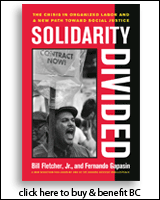
|
 |
 |
 |
| |
| |




















